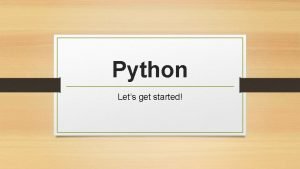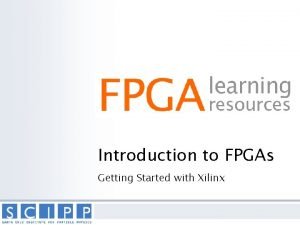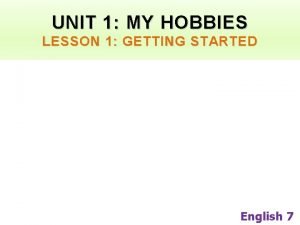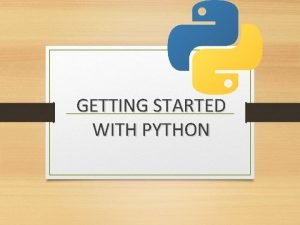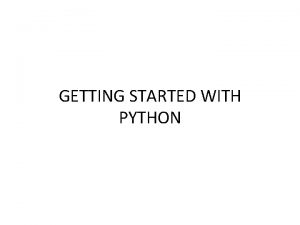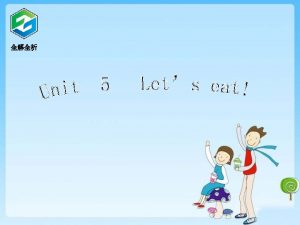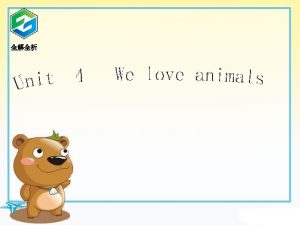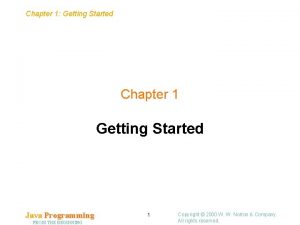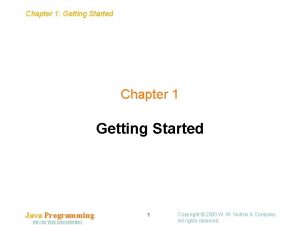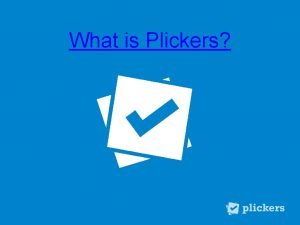Python Lets get started Getting Started Two modes


























- Slides: 26

Python Let’s get started!

Getting Started • Two modes: • Interactive • Script ** we will be working in script mode for the most part

Running a program • • Open IDLE File New Window File Save (add “. py” to your file, it may not add it automatically) Run Module

Functions • A “function” is a pre-written code that will perform a specific task • Python comes with a number of pre-written functions, but you can also write your own (as we will later on in this class) • Functions begin with a keyword and are followed by a set of parentheses • Ex: print ( )

Functions • Functions can pass what we call “arguments”, which are placed inside the parentheses of the function • Ex: print (“Hello, world!”) • Different functions will expect different types of arguments (more on types of arguments later) • When you use a function on python, we say we are “calling” a function

Types of Data • There are three types of data that we will use in Python for our purposes • Strings: textual data • Integers: numerical data, restricted to integers • Floats: numerical data, decimals included

Strings • A string is data that is textual in nature • Strings can contain none or some characters • “String literals” are strings defined within your program/function and must be “delimited” by a special character which tells Python to treat it as textual data, and not as a function • Ex: print (“Hello, world!”) • Ex: print (“print”)

Delimiters • Python recognizes three types of delimiters • The single “tick” : • The single “quote” : • The triple quote : ( ‘ hello ’ ) ( “ hey there! ” ) ( “”” what’s up dude “”” )

Print Challenge • Try to write a Python program that prints the following lines of text: Hello, my name is Bruce! Hi, Bruce! Fish are friends, not food!

Print Challenge • Now try these: Bruce asked, “When was the last time you had fish? ” He’s leading an FEA group. FEA stands for “Fish Eater’s Anonymous. ”

Print Function • You’ll notice that the print function will automatically add a line break after it prints your argument • “”” the triple quote delimiters can be used for data that is on multiple lines

Printing multiple arguments • The print function can accept none or multiple arguments at a time • Multiple arguments can be separated by a comma • Example: print (“Hello!”, ‘my name is’, “Donald”) • The print function will automatically insert a space between any two arguments (we will learn how to avoid this later on)

Commenting your program • As we mentioned, your programs can become very long, so you will want to write comments either for yourself or another user • Python recognizes the symbol # as a commentator symbol, so it will ignore everything that comes after that symbol on the same line # First, I will ask the user for their name, I will then store it in a variable called “x” x = input (“What is your name? ”) # Now, I will print the name of the user print (x)

Multi-line comments • You can also input multi-line comments on Python using the triple quote delimiter “”” Python will ignore this line And this one too “”” print (“Hello, world!”)

Comments as Pseudocode • Comments are often used as pseudocode in order to outline the task at hand • Ex: #get two test scores from user # add test scores # divide by 2 # print out result

Comments as a debugging technique • Comments can be used for debugging because Python will ignore portions of your code • Debugging means to identify and to remove any errors in your code # I don’t know why this one isn’t working! # print ( ‘ Hello, world! ” )

Variables • Variables are like buckets that hold and store information in your computer’s memory • You can create a variable by using the following syntax: • variablename = data Examples: speed = 5 name = “Donald” • The “=” is the assignment operator and it tells Python to store data on right of operator into variable, named on the left of the operator

Rules on naming variables • You cannot use reserved words (they are listed on the next slide) • Variable names can’t contain spaces but they can contain an underscore “_” • The first character of a variable name must be a letter or an underscore, it cannot be a numerical value • Python is case sensitive (variablename vs. Variable. Name)

Reserved words • These words cannot be used as variable names: False, True, None, and, assert, break, class, continued, def, del, elif, else, except, finally, for, from, global, if, import, in, is, lambda, nonlocal, not, or, pass, raise, return, try, while, with, yield (you’ll notice, True, False, None have capital letters) • Reserved words will show up in a different color while writing in script mode

Examples class = 2 Class = 2 class. Avg = 24 _class_avg = 42 2 ndclass. Avg = 56 classavg! = 99

Examples class = 2 illegal (reserved word) Class = 2 legal class. Avg = 24 legal _class_avg = 42 legal 2 ndclass. Avg = 56 illegal (can’t start with a number) classavg! = 99 and “_” ) illegal (only alphanumeric values,

Common Variable Naming Techniques • Some variable names can be hard to read, so there are common techniques that are used to distinguish them: cartopspeed = 140 car_top_speed = 140 car. Top. Speed = 140 car_top_speed_3 = 140 # hard to read …

Printing variables • You can print the data that is stored within a variable by passing the variable as an argument into the print function name = “Donald” print (name) print (“Hello, my name is”, name) >> Donald >> Hello, my name is Donald

Changing variables • Variables are called variables because the data stored in them can be changed • You can change the value/data stored in a variable with a second assigning statement dollars = 19. 99 print (“I have”, dollars, “in my account”) dollars = 10000. 99 print (“Now, I have”, dollars, “in my account”)

Multiple Assignments • You can assign multiple variables on the same line: x, y, z = 1, 2, 3 # the variables will assume the values in order • You can also assign the same value to multiple variables x = y = z = 10 # variables x, y, and z will all hold the value of 10

Practice • You’re working on a simple inventory management system for a small store. You’d like to store the name and price of two products and print them, so that your inventory page looks something like this: Item: Bread, price: $ 1. 99 Item: Eggs, price: $ 3. 49
 The secret of getting ahead is getting started
The secret of getting ahead is getting started Get in get on get off get out
Get in get on get off get out Lets get started images
Lets get started images Song with poetic devices
Song with poetic devices Two modes of python
Two modes of python Getting started with vivado ip integrator
Getting started with vivado ip integrator Unix for bioinformatics
Unix for bioinformatics Education.splunk
Education.splunk Rancher slack
Rancher slack Getting started with excel
Getting started with excel Outlook tutorial 2010
Outlook tutorial 2010 Counter code
Counter code Lua getting started
Lua getting started Lesson 1 hobbies
Lesson 1 hobbies Unit 1 local environment
Unit 1 local environment Unit 1 getting started
Unit 1 getting started Infuecers gone wild
Infuecers gone wild Hi3ms
Hi3ms Perl getting started
Perl getting started Getting started with ft8
Getting started with ft8 Unit 3 getting started
Unit 3 getting started Unit 1 getting started
Unit 1 getting started Poll everywhere register
Poll everywhere register Android development getting started
Android development getting started Tipos de habilidades del pensamiento
Tipos de habilidades del pensamiento Getting started with eclipse
Getting started with eclipse Mathematica getting started
Mathematica getting started




